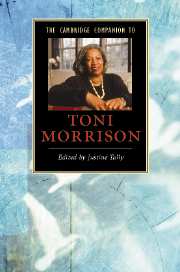Book contents
- Frontmatter
- Introduction: “All necks are on the line”
- Part I Toni Morrison’s fiction
- 1 The Bluest Eye and Sula: black female experience from childhood to womanhood
- 2 Song of Solomon and Tar Baby: the subversive role of language and the carnivalesque
- 3 Beloved or the shifting shapes of memory
- 4 Jazz and Paradise: pivotal moments in black history
- 5 The Morrison trilogy
- 6 Love and the survival of the black community
- 7 The artistic impulse of Toni Morrison’s shorter works
- Part II Toni Morrison’s criticism and editing
- Part III Essays
- Part IV Further Reading
- Index
3 - Beloved or the shifting shapes of memory
from Part I - Toni Morrison’s fiction
Published online by Cambridge University Press: 28 January 2008
- Frontmatter
- Introduction: “All necks are on the line”
- Part I Toni Morrison’s fiction
- 1 The Bluest Eye and Sula: black female experience from childhood to womanhood
- 2 Song of Solomon and Tar Baby: the subversive role of language and the carnivalesque
- 3 Beloved or the shifting shapes of memory
- 4 Jazz and Paradise: pivotal moments in black history
- 5 The Morrison trilogy
- 6 Love and the survival of the black community
- 7 The artistic impulse of Toni Morrison’s shorter works
- Part II Toni Morrison’s criticism and editing
- Part III Essays
- Part IV Further Reading
- Index
Summary
I must trust my own recollections. I must also depend on the recollections of others. Thus memory weighs heavily in what I write.
There is a necessity for remembering the horror, but of course there's a necessity for remembering it in which . . . the memory is not destructive.
Beloved (1987) occupies a singular place in Morrison's oeuvre. One of the most important American novels of the post-war era, it went on to win the Pulitzer Prize for fiction (1988) after a national controversy that mobilized Black intellectuals and artists. When first writing the book, Morrison was obsessed with fragments of stories about two different incidents: a child-murder by an ex-slave, and the forgiveness of a young lover who helped her murderer escape the police. Although she cannot explain the connection, something seemed clear to her: “a woman loved something other than herself so much. She had placed all the value of her life in something outside herself” (CTM, 207). The project later developed into the trilogy Beloved, Jazz (1992), and Paradise (1998). The topic - remembrances of slavery around the tragic core of infanticide - partly accounts for the novel's success. Situated in 1873, after the abolition of the Peculiar Institution, Beloved deals with the recollections - what people remember - and the memory of slavery - the act of remembering. It probes its effects on the individual psyche of black and white people, but also the repressed memory of slavery in the make-up of the American nation.
What makes Beloved stand out is the centrality of memory in the poetics of the text and as subject matter. As she acknowledges, Morrison set out to write about the “interior lives” of the slaves to “fill in the blanks” that were left out of the slave narratives when the narrators drew a veil over “proceedings too terrible to relate” (SM, 193,191).
- Type
- Chapter
- Information
- The Cambridge Companion to Toni Morrison , pp. 43 - 58Publisher: Cambridge University PressPrint publication year: 2007
- 7
- Cited by



